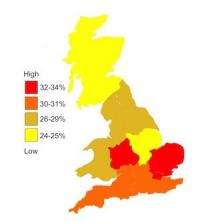Mass participation dream experiment launches

Is it possible to influence people as they sleep and give them their perfect dream? Today sees the launch of a new study that uses a specially designed iPhone app in an attempt to improve the dreams of millions of people around the world. If successful, the study will allow people to create their perfect dream and so wake up feeling especially happy and refreshed.
This study was launched at the Edinburgh International Science Festival by psychologist Professor Richard Wiseman from the University of Hertfordshire.
Wiseman has teamed-up with app developers YUZA to create 'Dream:ON' - an app that monitors a person as they sleep and plays a carefully crafted 'soundscape' when they dream. Each soundscape has been carefully designed to evoke a pleasant scenario, such a walk in the woods, or lying on a beach, and Wiseman hopes that these sounds will influence people's dreams. At the end of the dream the app sounds a gentle alarm and prompts the person to submit a description of their dream into a database known as 'The Dream Catcher'. Users of Dream:ON are also encouraged to share their dreams via Facebook and Twitter.
Each night Wiseman will collect thousands of dream reports and use the information to discover whether it is possible to give the world sweet dreams.
"The app is free and we want as many people as possible to participate," noted Wiseman. "I have conducted many mass participation experiments in the past, but this is by far the most ambitious and exciting."
As part of the launch, Wiseman has carried out a national survey into dreaming. The results demonstrate the need for sweeter dreams, with 21% of respondents reporting that they have trouble sleeping and 15% suffering from unpleasant dreams (see the 'UK dream map').
"Getting a good night's sleep and having pleasant dreams boosts people's productivity, and is essential for their psychological and physical well-being. Despite this, we know very little about how to influence dreams - this experiment aims to change that" commented Wiseman.
The exact percentage of people in each region reporting pleasant dreams are as follows:
East Midlands 24
Scotland 25
North East 28
North West 29
Yorkshire and the Humber 29
Wales 29
South East 30
South West 30
London 32
East of England 33
West Midlands 34
How does the Dream:ON work?
Before going to sleep, people indicate when they would like to wake-up and select a 'soundscape'. They then place the iPhone onto their bed. Dream:ON then monitors the person's movements twenty minutes before they awaken. If Dream:ON detects a lack of movement - indicative of dreaming - it plays the desired soundscape. When the person starts to move again Dream:ON plays a gentle alarm and prompts them to submit a brief description of their dream. These descriptions are stored in a database and, over time, will be used to examine how the soundscapes influence people's dreams. Dream:ON is free to download and contains a state of the art smart alarm clock as well as soundscapes to help influence your dreams.
Dream:ON is for iPhone at launch and available now for free from iTunes - globally.
10 Famous Dreams
Many researchers now believe that dreams are a rich source of creative thinking. Here are 10 famous creative dreams:
1) Research chemist Friedrich August Kekule dreamt about a snake grabbing its own tail, which led to him discovering that the Benzene molecule has a circular structure.
2) Elias Howe dreamt about being taken captive by a tribe who danced around him with spears that had holes near the tips. This dream led to his invention of the sewing machine.
3) Robert Louis Stevenson dreamt about the plot of "The Strange Case of Dr. Jekyll and Mr. Hyde". He then completed the book within ten weeks.
4) Stephen King has used his dreams for inspiration for many of his novels, including 'Misery' and 'It.'
5) Paul McCartney awoke to find the tune for 'Yesterday' fully formed in his head.
6) Jack Nicklaus invented a new golf swing after dreaming that he was holding his golf club in a completely different position.
7) Samuel Taylor Coleridge wrote his famous poem, Kubla Khan, after waking up from an opium-affected dream.
8) The basic plot for the Twilight series came to writer Stephanie Meyer came in a dream.
9) Mary Shelley found the inspiration for Frankenstein in a dream about the possibility of scientists discovering how to create life.
10) Russian scientist Dmitri Mendeleyev dreamt about how atomic weights could be used to group the elements, and was inspired to create the Periodic Table.
More information: Project website and download link for app : dreamonapp.com/


















